Habit (Riding Habit)
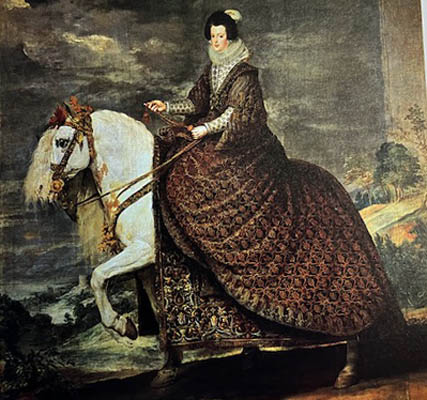
|
[Equestrian Apparel] Formal clothes worn while riding. The term is now mostly applied to female outfits worn while riding sidesaddle.
Hack
[Equine Activity] A hack is a recreational ride that in most cases is distinct from forms of competitive riding. However, there are competitive events based on a pleasure riding format. The term hack is commonly used in the United Kingdom and occasionally in areas of the U.S. In the United States most riders use the term trail riding. The term was also used for crossbred riding horse, a horse for hire or a worn out horse.
Hackney
[Horse Breed] The Hackney Horse was developed in Britain as a fast, high-stepping trotter with a flashy appearance that is capable of long-distance trotting.Hackamore
> [Equine Equipage] A hackamore is similar to a bridle but lacks a bit. It relies on exerting pressure via its noseband on the horse's face.
Haflinger Horse
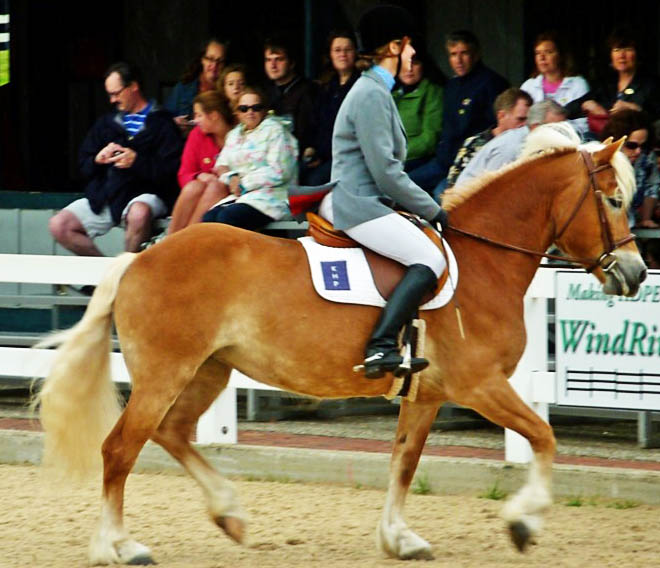
|
[Equine Breed] Haflingers are a small horse breed native to the Tyrol region in Europe. They are adapted for use in mountainous terrain and are strong and hardy. Haflingers are always a shade of chestnut in color. They are popular as a driving animal in smaller conveyances.
Half Cheek Snaffle Bit
[Equine Equipage] A half cheek snaffle bit only has arms set below the rings rather than above and below as in the full cheek snaffle..
Half Halt
[Advanced Riding Technique] In a half halt the rider gives a brief and subtle signal to the horse, using the rider's seat, legs, and hands to rebalance the horse's weight and for the horse to prepare for the next movement that might be for example, a transition or a jump. The term is a misnomer in that the horse continues moving and does not really halt during a half halt. If the horse does halt the rider is being less than subtle applying their aids.
Half Pass
[Dressage] In a half pass the horse moves both forward and to the side crossing its legs in the process. You will notice that the horse's body is slightly bent in the direction of movement. This is distinct from a full pass in which the horse moves almost entirely sideways with minimal forward movement.
Half Seat (Two-Point Contact)
[Basic Riding] Half seat is when a rider rises in the saddle. There is still contact with the knees and calves on the skirt of the saddle but the seat of the rider is out of the saddle. More body weight is transferred to the heals in the stirrups and the rider usually leans forward to an appropriate degree. During a gallop and going into a jump a rider should be in two-point contact. It is also used over rough ground and going uphill.
Halt
[Basic Riding Technique] With a halt a moving horse is asked to promptly stop and stand still. The feet should be squared with each other and the horse straight and balanced evenly on all legs.
Halter (Headcollar by British usage)
[Equine Equipage] A halter is a bitless fitting for a horse's head, similar to the headstall of a bridle. It is used to hold a horse in place or lead them. The are commonly made of leather, nylon or rope. I believe that nylon halters should not be used without close supervision. In an emergency a horse is unable to break out of one if it is tangled and they unlike rope halters they are difficult to cut. However, you can go through a lot of leather halters if a horse tends to act up in a trailer. Always have a spare one in your trailer.
Halter Class (In-Hand- British Usage)
[Showing] In a halter class horses are shown in a halter without tack or a rider and judged on their conformation and suitability for breeding. There is also halter showmanship in which young handlers are judged on their ability to groom and present a halter horse rather than on the horse itself.
Hame
[Equine Harness Equipage] The hames of a horse collar are wooden or metal bars that are the parts of the collar of harness that attaches the collar to the traces.
Hand
[Equestrian Unit of Measurement] This is used in speaking of the height of a horse and equals 4 inches or 10 centimeters metric. Horses are generally are 15 to 17 hands tall. Ponies are smaller. Horses height is measured from their withers which is a stationary body part unlike their head. The record height of a horse was a draft horse named Big Jake acknowledged by Guinness World Records as the tallest horse in the world, at 20 hands, 2.75 inches (82.75 inches). Ever notice that they all seem that big when you are trying to mount.
Hand Gallop
[Equestrian Gaits] A hand gallop is a collected gallop that is faster than a canter and not so fast as a full gallop. It is always done with the rider in a two-point position in the saddle.
Hands
[Equestrian Attributes] A rider with good hands demonstrates a high degree of finesse with the use of movements of the hands to signal intent to the horse. This is important in all riding, but particularly developed in dressage riders.
Handicap Race
[Horse Racing] A handicap race is one in which a handicaper assigns a certain account of extra weight to horses with better win records in an effort to achieve parity among the entries.
Handy Hunter Classes
[Horse Show Category] Handy hunter classes judge the maneuverability of a horse on a course. It may be called over fences, when jumping is included or under saddle, if jumping is not included. The word "handy" implies a horse that turns well (is supple) and well balanced during movements. The word hunter is used as the skill set required is similar to that needed on a typical hunt field.
Hang a Leg
[Equestrian Jumping Fault] A horse is said to be hanging a leg when passing a rail it allows one leg to dangle lower than the other rather then properly drawing them up together and near to the body. There is a danger that the one leg will pass the over the rail, while the other takes it down. There may be correctible problems with the horse, rider or even the saddle fitting that are causing this.
Hanoverian Horse
[Horse Breed] Hanoverians are a warm-blooded breed, known for their elegance, strength and athleticism. The breed was established at the Hanoverian State Stud farm at Celle, which was founded in 1732 by George II, the King of England and Elector of Hanover. The breeders were looking for a multipurpose horse that might be used as a military mount but also an elegant carriage horse. Today Hanoverians are well represented among horses featured in various kinds of competitive sport riding disciples.
Hansom Cab
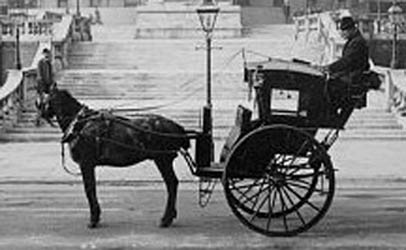
|
[Horse Drawn Vehicle] A Hansom Cab was a popular cab invented in 1834. They were a two-wheeled carriage for two passengers, with the driver seated behind the roof and a single horse. They were light weight, agile and maneuverable in heavy traffic.
Hard Mouth
[Equine Characteristic] A horse with a hard mouth does not respond to the usual supple bit pressure used by riders. This tends to happen with horses who have been ridden with harsh bits or have been repeatedly jerked in the mouth by inexperienced riders.
Hark
[Fox Chasing] "Hark" is called by a hunter for silence when fellow hunters are having a conversation that might obscure sounds that would indicate the hunt is on the trail of a fox. Often groups of hunters are widely dispersed over the country side and there is no line of sight between the hounds and some elements of the field. The ability to hear horns or the distant cry of the hounds can be critical. You might wonder if such an archaic term is still in modern use, but I can assure you it still is. I seem to hear it every time I open my mouth when fox chasing.
Harnessing
[Driving] Harnessing is the act of attaching the harness to a horse-draw vehicle or load.
Harness Race
[Horse Racing] A harness race is done by a driver using a sulky and trotting or pacing Standardbred Horses. The term Jockey is not used in harness racing.
Harrow
[Pasture Management] See Chain Drag Harrow
Haunches
[Equine Anatomy] A horse's haunches are his hindquarters, the rump and rear legs.
Haw
[Voice Commands] Haw is the voice command for a draft or plow horse to turn to the right. The word gee is used for a left turn.
Hay
[Equine Food Stuff] Hay is cut and dried grass, fed as fodder at times when pasture grass is unavailable. Hay is primarily digested in a horse's gut through the action of bacteria, located in the part of the gut called the cecum. The cecum is where microbes ferment the fiber found in hay, breaking it down into usable nutrients for the horse. This is another example of the many partnerships found in nature. In prior times it was believed that hay should "settle" for a year before being used. Current thinking is that one should wait about 6 to 8 weeks and that the loss is only about 5%. After that it is almost negligible up to 2 years of storage. The one thing that is lost very quickly from hay is carotene, so you might add carrots, a very rich source of carotene, in the winter. Vitamin A, which comes from carotene is added to most feed, so if a horse gets both feed and hay, it should be fine.
Hay Feeder (Covered Hay Feeder)
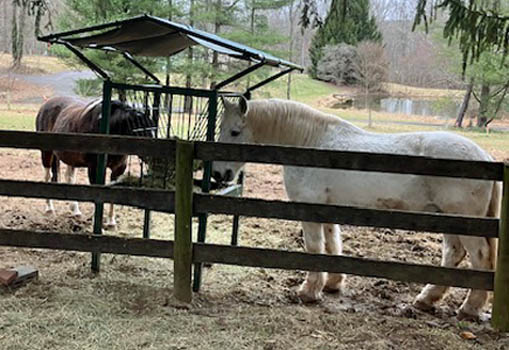
|
[Horse Management] A covered hay feeder is an enclosure that is set off of the ground and has some kind of a cover or roof to keep rain out. They come in various designs. The advantages of using one is that they conserve on hay that ground feeding tends to waste.
Hay Net
[Feed Equipage] A hay net is a means of suspending flakes of hay off of ground level. They are often used in a stall or inside or outside a horse trailer. Hay left on the ground is often scattered or defecated on and inside of a trailer it cannot be reached.
Hazer
[Rodeo] In steer wrestling a hazer is the second rider in the arena who rides parallel to the steer and keeps it running straight for the benefit of the primary rider, who is called the bulldogger. The bulldogger must then grab the steer by the horns, slip out of the saddle and wrestle the steer to the ground. The hazer's horse is called a hazing horse.
Head (Head of a Saddle)
[Equine Equipage] The head of a saddle is the front arch of the saddle, which spans the back part of the withers when the saddle is sitting on the horse's back.
Head Carriage
[Equine Posture] Head carriage is the position of the horse's head and neck in relation to the rest of its body. The position may be a natural one, governed by its situation, or one governed by the rider. A resting, sedated or sleeping horse has a low head carriage. An alarmed or startled horse or a dressage horse in a show may have a very high head carriage. The term self carriage is a horse's natural position according, to his conformation. For example, the self carriage of a western stock horse is typically lower than other horses and level with it's withers.
Head Land
[Ground Descriptor] Head land is the uncultivated edge of a planted field that is often allowed to grow up with brush or trees. Since it is not cultivated the ground is firmer than in the field. If one has permission to ride on the land, it is courteous to avoid tearing up the field by riding on the head land. However, if you do so watch out for animal borrows and low tree limbs. There is a lot of situation awareness a rider must have to keep himself and the horse safe.
Head Shaking
[Equine Behavior] Head shaking is a vice, in which the horse repetitively shakes its head from side to side for no clear reason. Some believe this is often an indication of a underlying veterinary problem and that might be ruled out rather than assuming it is totally behavioral. An entity, called trigeminal nerve-mediated headshaking, has been defined and is believed to result from neuropathic facial pain. The would be similar to trigeminal neuralgia in humans. Head shaking also might be as simple as the horse indicating it is uncomfortable with the bridle.
Head Shy
[Equine Behavior] A head shy horse overreacts to a human making movement near or touching its head. It can be an indication of prior abuse. For all kinds of good reasons a horse should never be struck in the region of its head.
Heading a Fox
[Fox Chasing] The term used when a rider interferes with the fox's chosen direction of travel and turns it during a chase. This prevents the hounds from properly following the fox's scent. This is considered very undesirable. Various elements of the field can be separated and need to be aware of their position relative to the progress of the hounds and likely position of the fox. This way they can avoid getting ahead of the fox and perhaps inadvertently heading it. The experience and judgment of the field master is critical here.
Headstall
[Equine Equipage] A headstall is that part of a bridle less the bit and reins that confine the horses head and thereby keep the bit and reins in place. They are generally constructed of a series of leather straps held in place with buckles and loops that can be unfastened for cleaning purposes.
Heaves (Recurrent Airway Obstruction)
[Veterinary Medicine] Heaves is a chronic respiratory disease characterized by airway inflammation and obstruction. It is similar to asthma in humans and is believed to be allergic in nature. Corticosteroids and bronchodilators are used in treatment.
Heavy Cavalry
[Military] Heavy cavalry was a category of mounted troops mounted on powerful horses and often armored. They were intended as shock troops to break the enemy's line of battle or envelope his flank. Improvements in firearms and artillery over time limited their role. The U.S. military never deployed heavy cavalry units.
Heavy Harness Rig
[Driving] A heavy harness rig is required for driving heavy vehicles or pulling heavy loads. It employs a full horse collar & hames type harness and breeching straps to allow the horse to hold or brake the load when going downhill.
Heavy in the Bridle
[Equine Behavior] A horse that pulls on the reins and may fight the bit is said to be "heavy in the reins." The rider can deliberately lighted the pressure, but by doing that control is surrendered and who knows what will follow. Trainers often suggest that a rider shift their horse's balance more to the hindend. That is something I have never been able to achieve myself in part because I never enjoyed ring work. So, this is not really my horses fault, but my own laziness. Horses naturally are “on the forehand," using their head and neck for balance and carrying the majority of the rider's weight on their front legs and shoulders. There are several ring exercises, including doing figure eights, that help horses to learn to carry more weight in the hindquarters and thus be more balanced and reduce any tendency to be heavy in the bridle.
Heel (Running Heel)
[Fox Chasing] Running heel is when the hounds follow the stent trail (line) in the wrong direction, heading opposite to the direction the fox was moving.
Hell for Leather
[Equestrian Expression] Riding hell for leather is galloping at an extreme pace for a protracted time.
Herd bound (Buddy Sour)
[Equine Behavior] A herd bound horse suffers what amount to an anxiety attack when removed from its herd or when the other horses are removed. It can be difficult to preform routine duties in the stable area when working with such a horse. Slowly building up a tolerance to leaving the herd will eventually solve the problem.
Highland Pony
[Equine Breed] Highlands are a hardy, large pony, native to Scotland. They are typically dun-colored and have primitive markings, The breed is categorized as a category 4, at risk by the Rare Breeds Survival Trust.
High Line
[Equine Equipage] A high line is a length of rope strung between two trees or more rarely between two horse trailers. It is then used to tie several horses on. The technique is used by people riding wilderness trails or camping with their horses. It is suggested that you use two tree-saver straps in order not the do damage to the trees. The line should be at a height higher than the tallest horse's head. Horses should be connected to the line using a metallic swivel piece that the line is fed through. Safety devices might include prepositioning a sharp knife, flashlight and attaching a bell to the line in the event some problem occurs during the night.
High School (French- Haute École)
[Equestrian Training] The high school refers to the pinnacle of classical dressage training as practiced at the various European riding institutions, such as the Spanish Riding School of Vienna or by the French Cadre Noir. The schooling is lifelong work for both human and animal moving towards a perfection that can never be totally realized.
Hill Topper
[Fox Chasing] Unmounted spectators or mounted members or guests to a fox chase that view the progress of the chase commonly from a hilltop that offers an overview of the chase fixture. They need to be patient when the hunt disappears behind a woods. Often they are friends or family members of the riders, photographers with long distant lenses or seniors, who no longer ride.
Hinney
[Equine Breeding] A hinney is the offspring of a male horse and a female donkey. They are less common than mules (offspring of male donkey and female horse). A hinny is smaller than a mule, with shorter ears and a lighter head. They are sterile.
Hippology
[Scholarship] Hippology is the study of horses. The term is also applied to an organized youth competitive event where participants demonstrate their knowledge of equine science and management.
Hippolphile
[Humane Characteristic] Hippophile is a person who is passionate about horses. The word equiphile is synonymous.
Hired Assassin
[Polo] Most polo clubs are composed of amateur players. However, some of these clubs have the financial ability to hire professional players to play on their team. These players are known as "hired assassins." The characterization is a good one since these individuals tend to score one goal after the other. Most hired assassins are Argentinean players and come from a country whose horsemen have truly embraced the game to a greater degree than anywhere else in the world.
Hog Mane
[Equine Grooming] A mane that has been cut so short that it stands up is called a hog mane. An additional term, roached mane, is felt either to be synonymous or to indicate a mane trimmed slightly longer than with a hog. Most horses are not groomed in this fashion.
Hobble
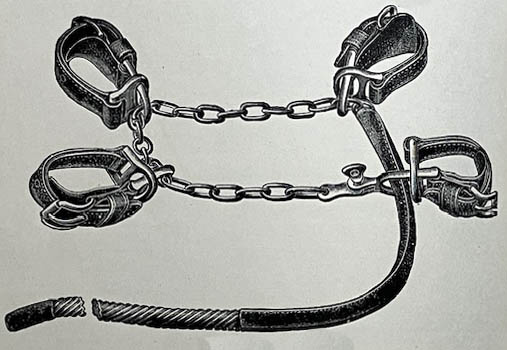
|

|
[Equestrian Equipage] A hobble is a heavy leather device that is fixed to a pair of legs to prevent a horse from moving. You might think of them as equivalent to human handcuffs, but they are designed to prevent the horse from injuring himself in them. I have had occasion to use them and the horse tolerated them better than I expected. Particularly in former times, hobbles where used to deliberately cast a horse to the ground in order to preform some procedure. They are still in use, mostly in various training situations and camping situations where hobbling is felt a better option than tying them.
Hock
[Equine Anatomy] The hock is the complex of hindlimb joints between the tarsal bones and tibia of a horse. It is equivalent to the human ankle and heel. It receives a lot of stress in a working horse and is a site accounting for some lameness issues. The posterior aspect of the hock forms an angle at the middle position of the horse's rear leg.
Hold Hard
[Fox Chasing] The command to hold hard is given to a member of the hunt by an official of the hunt when there is a need for the rider to urgently halt his horse.
Holsteiner (Holstein)
[Equine Breed] Holsteiners are a warm-blood breed from the Schleswig-Holstein region of northern Germany. They are valued in various equestrian sports including show jumping, dressage, combined driving and eventing. They have a Roman nose, arched, high-set necks and powerful hindquarters. In prior centuries they were employed as a war and latter coach horse and now breeders are focused on developing their jumping ability. It is a good example of how a breed survives by changing with the times and the demands of the trade.
Homestretch
[Horse Racing] The homestretch is one of the four sections of an oval race track and is the one that is a straightaway closest to the viewing stand. The starting and finish lines are along the homestretch.
Hoof Boots
[Equine Equipage] Hoof boots are tough rubber or plastic horse boots, designed to provide removable protection for a horse's hoof. Keeping horses unshod has become popular, but in dry weather riding surfaces become hard and the boots can be used temporarily in place of getting the horses shod. In practice they can get sucked off in muddy areas and must be fit correctly.
Hoof Knife

|
[Farrier Equipment] A farrier uses a hoof knife as an initial step in removing dirt, exfoliated sole material and trim the shedded material from the frog.
Hoof Nipper
[Farrier Equipment] A farrier uses a steel hoof nipper to trim the away excess hoof wall at the edges of the hoof.
Hoof Pick
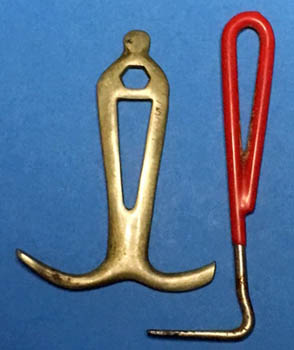
|
[Equine Equipage] A hoof pick is a metal tool used to clean the bottom of a horse's hoof.
Hoof Rasp

|
[Farrier Equipment] A Hoof Rasp is a heavy duty file, used by a farrier to do a final trimming and shaping of the hoof edge and sole. It is important it that the angle that the hoof rests on the ground must be properly maintained.
Hoof Tester
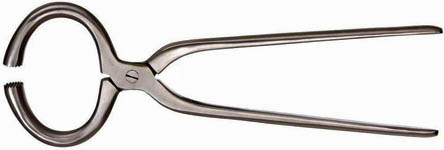
|
[Veterinarian Equipment] A veterinarian uses a blunt, scissor-like hoof tester as part of a lameness evaluation, while checking for tenderness by applying pressure to the hoof wall.
Hooking On
[Polo] When a competitor in polo catches his opponent's mallet head with his own and impedes his shot. This move is allowed in the game.
Horn (Hoof Wall)
[Equine Anatomy] The horn of a horse's hoof is the hard, keratinized, outer surface of the hoof.
Horse Brasses (Amulets)
[Decorative Harness Equipage] Horses brasses are decorative brass plaques suspended from horse harness gear. They became very popular in 19th century Britain and were also collected and used for wall displays. Similar plaques have been found in Roman and Celtic archeological sites.
Horse Fly (Tabanus sulcifrons)
<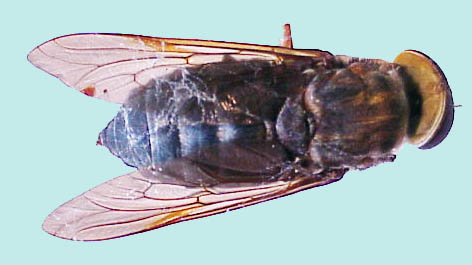
|
[Equine Pest] Encounters with horse flies may be the stuff of rider's nightmares. Your first warning is the loud buzzing sound of an approaching horse fly. They are large flies and not particularly fast. Often you can discourage them with a few swings of your fly wisp. If not they tend to land in certain places on the horse, among them the mane, the shoulder or the rump. Assuming crushing the fly is better than being bucked off, a strong, determined swat with you hand will kill it. A horse fly's bite, if you have never been bitten by one, is very painful and horses tend to react with running and bucking. If you are leading a horse, watch yourself. It is better to let go than get kicked by accident. These flies do not breed in manure, but in wet soil. Females need a blood meal to reproduce. They do not swarm in a group, but attack individually.
Horse Marines
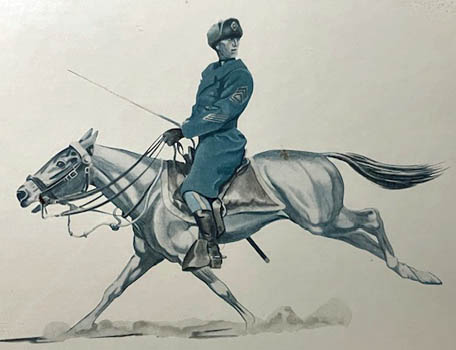
|
[Military] The term horse marines was intended as being humorous or derisive. What use are horses to marines, serving on ship board? In fact, there were marine units that were mounted during periods of shore duty both in the United States and British service.
Horse Racing
[Equine Sport] Horse racing no doubt goes back to the first two people who became accomplished riders. Modern horse racing can be broken down to flat racing with Thoroughbreds, Arabians or other breeds, steeple chasing, various timed events in other competitive equestrian sports, and harness racing. Modern parimutuel racing is a huge industry and very much in the public eye. Eighty years ago it was even more so. Today, the sports are receiving much criticism from the public as a result of the revelation of suspicious horse deaths at tracks and allegations of cruelty by animal rights groups. I seriously hope the industry will see the need to better police itself. There is no reason that the industry cannot both provide good sporting events and humane animal care.
Horse Whisperer
[Training] A horse whisperer is that trainer, who seems to get rapid and amazing results when working with horses. Their basic approach is working from an understanding of the animals' natural instincts and using non-coercive methods. There is controversy as to who was the original horse whisperer and the term as also the title of a major 1998 motion picture. Watching a trainer's exhibition of applying these techniques is always impressive.
Hot-Bloods
[Horse Breed Category] Hot blooded breeds are breeds said to be fast, energetic, often flighty, and relatively poor keepers. Thoroughbreds and Arabians are said to be hot-blooded breeds but Arabs are fairly good keepers. A hot-blooded horse can made a very good riding horse if worked regularly and schooled but many riders would rather have a more reliable, mixed or cold-blooded riding horse.
Hot Shoeing
[Farrier Craftmanship] In hot shoeing a farrier fits a horse shoe to the shape of the hoof by means of heating it on a forge and bending it with a hammer. However, the vast majority of shoes now in use are premade keg shoes rather than those made by hot shoeing.
Hunt Breakfast
[Fox Chasing] A traditional spread served after a hunt is over, regardless of the time of day.
Hunter Clip
[Equine Grooming] A hunter clip is commonly done by fox chasers in the winter to prevent a horse with a winter coat from becoming overheated on the hunt field. Often nearly the entire body can be chipped with the exception of area under the saddle or legs. Other riders may prefer to customize the areas, allowing more hair in certain areas. Liberal usage of a blanket is necessary when a horse is clipped.
Hunter Clip
[Equine Grooming] A hunter clip is commonly done by fox chasers in the winter to prevent a horse with a winter coat from becoming overheated on the hunt field. Often nearly the entire body can be chipped with the exception of area under the saddle or legs. Other riders may prefer to customize the areas, allowing more hair in certain areas. Liberal usage of a blanket is necessary when a horse is clipped.
Hunter Pace
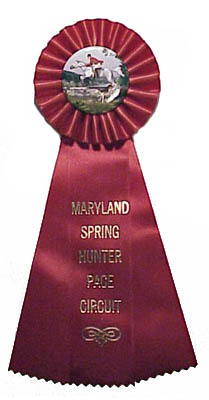
|
[Equestrian Event] A hunter pace is a cross country event over water and jumps where a predetermined optimum time is the key to winning. Often these are sponsored by local hunts and feature a kind of simulated hunt field (well, maybe a bit more of a civilized one without the multi-floral rose, etc.).
Hunting Canteen
[Fox Chasing] A hunting canteen is a leather case designed to hold both a flask of liquid and a sandwich case, while on the hunt field. It is attached by three straps, two going to the side of the saddle and one running forward and looping around a billet strap.
Hunt Seat (Jumping, Forward or Hunter Seat)
[Basic Riding] The hunt seat is one of three principle seat positions in riding. A rider sitting in a hunt seat is carrying weight forward and just behind the horse's withers as opposed to the classical seat in which the weight is carried farther back and more over the spine. English saddles variations are designed either for forward or classic seat riding. The forward seat is useful in more athletic riding; such as, jumping and used in fox chasing. The classical seat, also called the equitation position, is used in dressage.
Hunt Staff
[Fox Chasing] The staff of an organized hunt consists of the masters, huntsman and the whippers-in. Other members observe as part of the field.
Hunting Etiquette
[Fox Chasing] Hunting etiquette is the code of conduct expected of members of a hunt and their guests on the hunt field. This is not a matter similar to the proper placing of silver ware, but is necessary for the smoot and safe functioning of the various elements of the hunt.
Hunting Horn
[Fox Chasing] A hunting horn is a short straight horn that the huntsman uses to make one of several note series that direct the hounds and followers on the hunt field. Basic calls are leaving covert and blowing out (no fox in the area and hounds to gather and move). Perhaps, the most recognizable call is the a series of short, staccato notes indicating that a fox is on the move and the hounds should hurry after.
Huntsman
[Fox Chasing] The huntsman is the man directly supervising the hounds during a hunt and responsible for their care at other times. In larger hunts he is a full time employee, working under the direction of the master of fox hounds or the master may in smaller hunts function in both rolls. Many of these men come from families with several generations having served in this role.